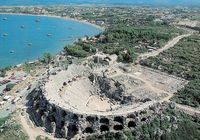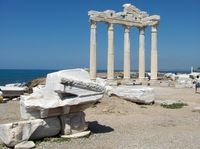Side was an ancient Pamphylian city. It is situated on a small north-south peninsula near to Manavgat. The ruins, amongst the most important in Asia Minor, include gates, temples, baths, a colonnaded street, a nymphaeum and a large theatre.
The present day
Near the town of Manavgat, Side is now a popular resort town and one of the best known classical sites in Turkey. The ancient city, sometimes known as Antik Side, is situated on a north-south peninsula about 1 kilometre long and 400 metres across.
History
The name Side is Anatolian in origin, and means pomegranate.
Strabo and Arrian both record that Side was founded by Greek settlers from Cyme in Aeolis, a region of western Anatolia: this most likely occurred in the seventh century B.C.
According to Arrian, when the settlers from Cyme came to Side they could not understand the dialect. After a short while, the influence of this indigenous tongue was so great that the newcomers forgot their native Greek and started using the language of Side.
Alexander the Great occupied Side, without a struggle, in 333 B.C. He left only a single garrison behind to occupy the city. He introduced the people of Side to Hellenistic culture, which flourished from the fourth to the first century B.C. After Alexander's death, Side fell under the control of one of Alexander's generals, Ptolemy I Soter, who declared himself king of Egypt in 305 B.C. The Ptolemaic dynasty controlled Side until it was captured by the Seleucid Empire in the second century B.C. Despite these occupations, Side managed to preserve some autonomy, grew prosperous, and became an important cultural centre.
In 190 B.C., a fleet from the Greek island city-state of Rhodes, supported by Rome and Pergamum, defeated the Seleucid King Antiochus the Great's fleet, which was under the command of the fugitive Carthaginian general Hannibal. The defeat of Hannibal and Antiochus the Great meant that Side freed itself from the Seleucid Empire.
The Treaty of Apamea (188 B.C.) forced Antiochus to abandon all European territories, and to cede all of Asia Minor north of the Taurus Mountains to Pergamum. However, the dominion of Pergamum only reached de facto as far as Perga, leaving Eastern Pamphylia in a state of uncertain freedom. This led Attalus II Philadelphus to construct a new harbour in the city of Attalia (the present Antalya), although Side already possessed an important harbour of its own. Between 188 and 36 B.C. Side minted its own money, tetradrachms, showing Nike and a laurel wreath (the sign of victory).
In the 1st century B.C., the Cilician pirates established their chief naval base and a centre for their slave trading in Side. The consul Servilius Vatia defeated these brigands in 78 B.C., and later the Roman General Pompey in 67 B.C. Thus, Side was brought under the control of Rome. Side established and maintained a good working relationship with the Roman Empire.
After the short reign of Amyntas of Galatia, between 36 and 25 B.C., in 25 B.C. Emperor Augustus reformed the state administration and placed Pamphylia and Side in the Roman province of Galatia. Side began another prosperous period as a commercial centre in Asia Minor, through its trade in olive oil. Its population grew to 60,000 inhabitants. Side also established itself as a slave-trading centre in the Mediterranean. Its large commercial fleet engaged in acts of piracy, while wealthy merchants paid for public works, monuments, and competitions, as well as the games and gladiator fights. Most of the visible ruins at Side date from this period of prosperity, which lasted until well into the 3rd century A.D.
In the 4th century A.D., Side’s defensive walls could not stop successive invasions by highlanders from the Taurus Mountains. During the fifth and sixth centuries, Side experienced another revival and became the seat of the Bishopric of Eastern Pamphylia.
Arab fleets raided and burned Side during the seventh century, contributing to its decline. A combination of earthquakes, Christian zealots and Arab raids, led to the site being abandoned by the 10th century. Side’s citizens emigrated to nearby Antalya.
In the twelfth century, Side established itself once more as a large city. An inscription found on the site of the former ancient city shows a considerable Jewish population in early Byzantine times. However, Side was abandoned again after being sacked. Its population moved once again to Antalya. Side became known as Old Antalya, and was buried.
In 1895, Greek Muslim refugees from Crete moved to Side and called their town Selimiye.
Archaeology
The ruins of ancient Side are among the most notable in Asia Minor. The peninsula houses a wealth of structures, and is separated from the mainland by the wall and moat.
Excavations have revealed several inscriptions written in Side language. The inscriptions, dating from the third and second centuries B.C., remain undeciphered, but testify that the local language was still in use several centuries after colonization. A basalt column base from the seventh century B.C., attributed to the Neo-Hittites, provides further evidence of the site's early history.
There are ruins of a theatre complex, built much like a Roman theatre. It relies on arches to support the sheer verticals. The Roman style was adopted because Side lacked a convenient hillside that could be hollowed out in the usual Greek fashion more typical of Asia Minor. The theatre seated about 8,000 people. With time and the shifting of the earth, the scena wall has collapsed over the stage, and the proscenium is in a cataract of loose blocks. It was converted into an open-air sanctuary with two chapels during Byzantine times (5th-6th century A.D.)
The well-preserved city walls provide an entrance to the site through the Hellenistic main gate (Megale Pyle) of the ancient city, although this gate from the second century B.C. is badly damaged.
Next comes the colonnaded street, whose marble columns are no longer extant; all that remains are a few broken stubs near the old Roman baths. The street leads to the public bath, which has been restored as a museum displaying statues and sarcophagi from the Roman period.
Next is the square agora with the remains of the round Tyche and Fortuna Temple (2nd century B.C.) In later times the temple was used as a trading centre, where pirates sold slaves.
The early Roman Temple of Dionysus is near the theatre. The fountain gracing the entrance is restored. At the left side are the remains of a Byzantine Basilica.
The other ruins of Side include three temples, an aqueduct, and a nymphaeum. Side's nymphaeum – an artificial grotto, with a natural water supply dedicated to the nymphs – was an elaborate building.
Turkish archaeologists have been excavating Side since 1947, and continue to do so from time to time.
Key Facts
- Side lies 66 km from Alanya, near the main Alanya-Antalya highway.
Shorex: Side is a great full day excursion for enthusiasts of archaeology, but also combines well with 11 or 13.





